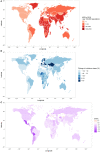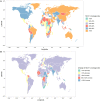Trends of the Global, Regional, and National Incidence of Measles, Vaccine Coverage, and Risk Factors in 204 Countries From 1990 to 2019
- PMID: 35127753
- PMCID: PMC8810814
- DOI: 10.3389/fmed.2021.798031
Trends of the Global, Regional, and National Incidence of Measles, Vaccine Coverage, and Risk Factors in 204 Countries From 1990 to 2019
Abstract
Background: Measles is a highly contagious disease that has caused global morbidity and mortality. Though great progress has been made in measles elimination, the resurgence of measles has been observed in recent years. As extant literature were mainly confined to data of local area, we conducted a systematic analysis to explore the trends of the incidence of measles, coverage rate, and the risk factors from 1990 to 2019 on global, regional, and national levels.
Methods: Data on cases of incidence, age standardized rate (ASR), vaccine coverage, and risk factors of measles were retrieved from the Global Burden of Disease (GBD) Study 2019 database. Estimated averaged percentage change (EAPC) of ASR was calculated to quantify the trends of measles incidence. Pearson correlation was applied to assess the association of EAPC and measles-containing vaccine coverage rate with socio-demographic index (SDI) in 2019, and the correlation between ASR and measles-containing vaccine coverage rate.
Results: Globally, there was a significant decrease in the number (84.18%) and ASR (6.13%, 95% CI: 5.41-6.84%) of measles incidence from 1990 to 2019. More than 80% of incidence cases were attributed to children under 5 and the proportion was highest in low SDI region. Countries and territories with low ASRs are mostly clustered in North America, Southern Latin America, and Western Europe, whereas those with high ASRs are mainly clustered in Africa, East Asia, and South Asia. Lower SDI was associated with higher ASR and lower vaccine coverage rate. The more the SDI value was further away from 0.6, the smaller the absolute value did EAPC have. Child wasting accounted for the most measles-related death cases, followed by child underweight, child stunting, and vitamin A deficiency.
Conclusions: Measles eradication is feasible, but urgently demands political commitment, financial support, and public engagement. In the context of COVID-19 pandemic and the global resurgence of measles, surveillance systems and routine immunization programs should be improved, while vaccine hesitancy needs to be addressed.
Keywords: incidence; measles; prevention; risk factor; trend; vaccination.
Copyright © 2022 Wang, Jing, Liu and Liu.
Conflict of interest statement
The authors declare that the research was conducted in the absence of any commercial or financial relationships that could be construed as a potential conflict of interest.
Figures






References
LinkOut - more resources
Full Text Sources
Research Materials

